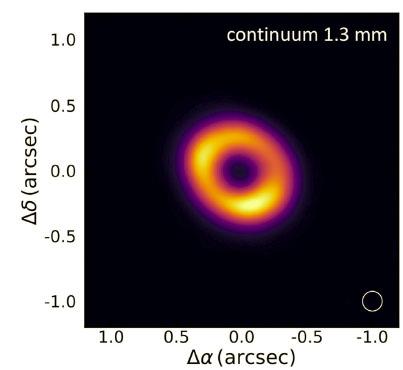
A millimeter image of the protoplanetary disc around the young star CG Tau converted to false-color shades of red. The white circle in the corner, shown for scale, is 25AU in diameter; the axes show the angular dimensions in arcseconds. The central gap in the disc is thought by astronomers to have been cleared by a planet of about eight Jupiter-masses orbiting the star at a distance of about twenty astronomical units.
Protoplanetary disks are a natural product of the star formation process. As material in a pre-stellar condensation collapses to form the central star, angular momentum conservation prompts it to develop a circumstellar disk. Planets form out of the material in these disks, whose structure and evolution are therefore keys to understanding the planet building process. Two main scenarios dominate in current theories. In the core accretion model, planets assemble through the aggregation of the dust grains, eventually forming planetesimals followed by a balance between their growth and fragmentation as they collide. In the alternative scenario, gravitational instabilities develop during the initial stages of the disk evolution and the associated density perturbations grow until they form into planetesimals.
In either of these two scenarios, young massive planets are expected to imprint their signatures on the structure of their parent disks, carving out cavities, gaps or other asymmetries which should be detectable. Infrared observations of young stars have uncovered a set whose emission seems to lack a contribution from warm dust. The implication is that the hottest dust closest to the star is absent, perhaps because a cavity has been carved out by an unseen, orbiting planet. Checking these ideas, and identifying examples of young stars in the midst of their planet birthing process, are key goals of modern exoplanetary research.
CfA astronomers Sean Andrews and David Wilner were members of a team that used the ALMA millimeter array to image the disk around CQ Tau, a young star about 530 light-years away that is known from infrared observations to have a cavity in its massive circumstellar disk, estimated to contain about .03 solar-masses of material. The dramatic new images have a spatial resolution of about twenty-four astronomical units (AU), more than enough to resolve the roughly face-on disk which is over 175 AU across (in our solar system, Pluto’s farthest passage is about fifty AU from the Sun). The ALMA images clearly reveal some details of a cavity in both the gas and dust components which the astronomers find to be between about 25 and 40 AU in radius. The team concludes that a massive planet roughly eight Jupiter-masses in size located at twenty AU can produce some (though not all) of the cavity's dimensions, and additional observations and modeling are needed to refine the picture. The new results, coupled with other ALMA observations by the team, offer ground-breaking details about the early stages of planet formation.
"A Dust and Gas Cavity in the Disc around CQ Tau Revealed by ALMA," M. Giulia Ubeira Gabellini, Anna Miotello, Stefano Facchini, Enrico Ragusa, Giuseppe Lodato, Leonardo Testi, Myriam Benisty, Simon Bruderer, Nicol´as T. Kurtovic, Sean Andrews, John Carpenter, Stuartt A. Corder, Giovanni Dipierro, Barbara Ercolano, Davide Fedele, Greta Guidi, Thomas Henning, Andrea Isella, Woojin Kwon, vweHendrik Linz, Melissa McClure, Laura Perez, Luca Ricci, Giovanni Rosotti, Marco Tazzari and David Wilner, MNRAS 486, 4638, 2019.